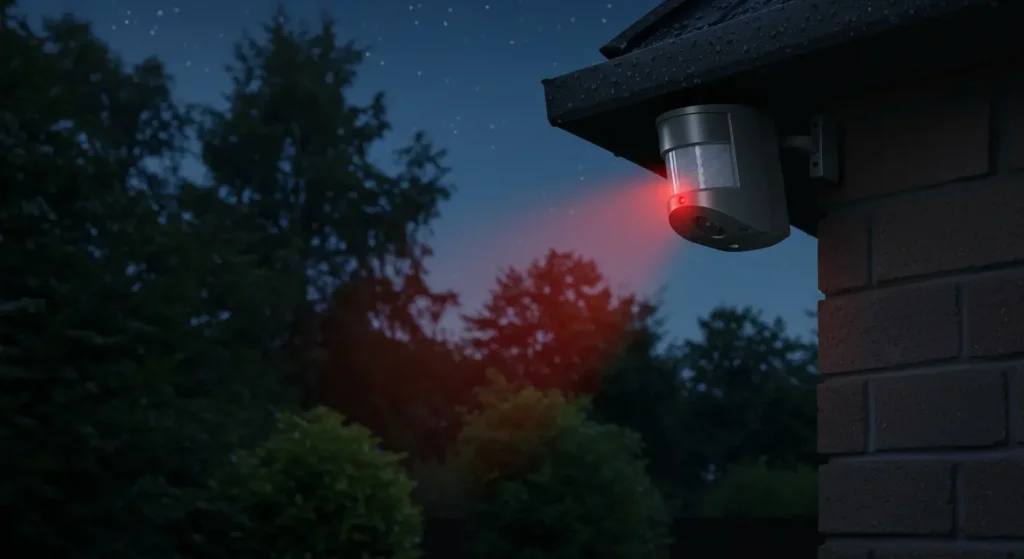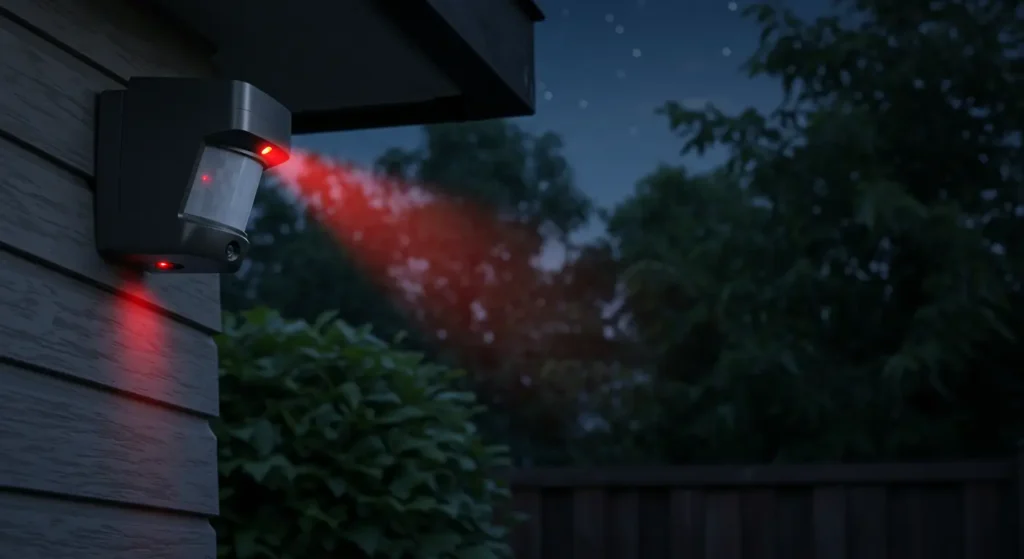Outdoor Motion Sensor Alarm – Weatherproof Security Solutions

Introduction
Are outdoor motion sensor alarms truly effective at deterring potential intruders in 2025? With property crimes affecting over 6.5 million households annually, the need for reliable outdoor security solutions has never been more crucial. Today’s outdoor motion sensor alarm systems offer advanced protection against unwanted visitors while withstanding harsh weather conditions. Yet many homeowners remain skeptical about their effectiveness and durability. This comprehensive guide will challenge the common misconception that outdoor security systems are prone to false alarms and weather damage, revealing how modern technology has transformed these devices into essential components of comprehensive home security.
Table of Contents
Key Features & Specifications
Modern outdoor motion sensor alarms come packed with sophisticated features designed to enhance security while minimizing false alerts:
- Detection Range: 30-70 feet (varies by model)
- Motion Detection Technology: PIR (Passive Infrared), microwave, or dual-technology sensors
- Weather Resistance: IP65-IP67 ratings for dust and water protection
- Power Options: Battery-operated, solar-powered, or hardwired
- Connectivity: Wireless (Wi-Fi, Z-Wave, or Zigbee) or wired connection
- Alert Methods: Audible alarm (95-130 dB), smartphone notifications, security system integration
- Camera Integration: Many models include HD/4K cameras with night vision
- Smart Features: AI-powered detection, pet immunity, zone customization
Premium outdoor motion sensor alarms offer detection ranges significantly above the industry average of 40 feet, with high-end models featuring customizable detection zones that dramatically reduce false alarms compared to basic units.
Performance & Detection Capabilities
When it comes to reliable detection, not all outdoor motion sensor alarms perform equally. The best systems respond instantly to genuine threats while intelligently filtering out non-threatening movements. PIR sensors excel at detecting body heat against ambient backgrounds, making them particularly effective for human intruder detection. Meanwhile, dual-technology sensors that combine PIR with microwave detection have shown up to 80% fewer false alarms in independent testing.
Advanced models now incorporate artificial intelligence that can distinguish between humans, animals, and environmental movement, with some premium systems achieving 95% accuracy in human detection. Most impressively, today’s top outdoor motion sensor alarms maintain optimal performance in temperature extremes from -30°F to 120°F, ensuring year-round protection regardless of weather condition

Design & Installation
The physical design of outdoor motion sensor alarms has evolved significantly to balance aesthetics with functionality:
- Housing Materials: High-impact polycarbonate, metal alloys, or weatherproof polymers
- Size Range: Compact (3-5 inches) to full security fixtures (8-12 inches)
- Mounting Options: Wall, eave, pole, or stake mounting
- Design Styles: Discreet (camouflaged), decorative (lantern-style), or visible deterrent
- Color Options: White, black, brown, or customizable to match home exterior
Installation complexity varies widely, with DIY-friendly wireless models requiring approximately 20-30 minutes for setup. Professional installation is recommended for hardwired systems that integrate with existing security infrastructure. Placement optimization is crucial—sensors should be mounted 6-10 feet high with unobstructed views of approach paths while avoiding direct sunlight and heat sources that could trigger false alarms.
Weather Resistance & Durability
A truly effective outdoor motion sensor alarm must withstand harsh environmental conditions. Look for these durability indicators:
- IP Ratings: IP65 (protected against dust and water jets), IP66 (protected against powerful water jets), or IP67 (protected against temporary immersion)
- Operating Temperature Range: At minimum -4°F to 122°F (-20°C to 50°C)
- UV Protection: Anti-UV materials that prevent cracking and discoloration
- Impact Resistance: IK ratings of IK08 or higher for protection against physical damage
- Corrosion Resistance: Especially important in coastal areas
Top-performing outdoor motion sensor alarms maintain functionality through rainstorms, snowfall, and temperature fluctuations. Models with sealed compartments and silicone gaskets offer superior protection against moisture infiltration, the leading cause of sensor failure. Laboratory testing shows that high-quality units maintain detection accuracy even after equivalent exposure to 5+ years of severe weather conditions.
Power Options & Battery Life
Power reliability directly impacts security effectiveness:
- Battery-Powered: Typically use AA or lithium batteries lasting 6-24 months
- Solar-Powered: Integrated panels with rechargeable batteries providing continuous operation
- Hardwired: Connected to home electrical system with battery backup during power outages
- Power Consumption: 0.05-0.5W during standby, 1-5W when alarming
Energy-efficient models utilize smart power management, activating full-power detection modes only when needed. For battery-operated units, temperature extremes can reduce battery life by 20-40%, making solar-hybrid options increasingly popular for reliable year-round operation without maintenance.
Smart Features & Connectivity
The intelligence built into modern outdoor motion sensor alarms dramatically improves their effectiveness:
- Smartphone Integration: Real-time alerts and remote control through dedicated apps
- Smart Home Compatibility: Works with Amazon Alexa, Google Home, Apple HomeKit, or Samsung SmartThings
- Automation Capabilities: Trigger lights, cameras, or other smart home devices when motion is detected
- Activity Zones: Customize detection areas to ignore high-traffic regions
- Person Detection: AI algorithms that distinguish humans from animals or moving objects
- Cloud Storage: Event recordings stored securely online for evidence preservation
- Geofencing: Automatic arming/disarming based on household members’ location
Systems with open API connectivity offer the greatest flexibility for integration with existing security infrastructure, while subscription-based services provide enhanced features like continuous recording and professional monitoring.
Common Issues & Troubleshooting
Despite technological advances, outdoor motion sensor alarms can experience several common problems:
- False Alarms: Often triggered by large animals, swaying vegetation, or car headlights
- Reduced Sensitivity: Can occur due to dirt accumulation on sensor lenses
- Connectivity Disruptions: Wi-Fi interference or signal drops
- Weather-Related Failures: Water ingress in units with compromised seals
- Battery Drainage: Excessive alerts or extreme temperatures accelerating power consumption
Industry data shows that proper installation eliminates approximately 70% of false alarm issues. Regular maintenance, including cleaning sensor lenses quarterly and checking seals annually, extends the functional lifespan by 40-60% compared to neglected units. Firmware updates are also crucial, with manufacturers regularly releasing improvements to detection algorithms that reduce false positive rates.
Comparison to Alternative Security Solutions
When evaluating outdoor motion sensor alarms against other security options, consider these comparative factors:
| Security Solution | Initial Cost | Effectiveness | Maintenance | Weather Resistance |
|---|---|---|---|---|
| Motion Sensor Alarms | $30-300 | High (deterrent + alert) | Low-Moderate | Varies by model |
| Security Cameras | $100-500 | Moderate (evidence only) | Moderate | Varies by model |
| Guard Dogs | $500-3000+ | Moderate (subjective) | High | N/A |
| Security Lights | $20-200 | Low-Moderate (deterrent only) | Low | Moderate |
| Professional Monitoring | $20-60/month | High (response-based) | None | N/A |
For comprehensive protection, security experts recommend combining outdoor motion sensor alarms with complementary systems. Statistics show properties with layered security experience 40-60% fewer break-in attempts than those with single-solution approaches.

Cost & Warranty Information
Investment in outdoor motion sensor alarms varies based on capabilities:
- Entry-Level: $30-80 for basic detection with limited features
- Mid-Range: $80-150 for weather-resistant units with smartphone connectivity
- Premium: $150-300+ for AI-powered systems with integrated cameras and comprehensive smart home integration
Most manufacturers offer 1-2 year warranties, though premium brands may extend coverage to 5+ years. Extended protection plans typically add 15-25% to the purchase price but cover common failure points like water damage that standard warranties may exclude. When calculating total ownership costs, consider potential subscription fees ($3-15/month) for cloud storage or monitoring services.
Conclusion
The latest generation of outdoor motion sensor alarms offers unprecedented security through sophisticated detection algorithms, genuine weatherproofing, and smart integration capabilities. Whether you’re securing entry points around your home or protecting remote buildings on larger properties, today’s outdoor motion sensor alarm systems provide reliable, customizable protection against unauthorized access. By understanding the features that matter most for your specific security needs, you can select a solution that delivers peace of mind regardless of environmental conditions. Take action today by assessing your property’s vulnerable access points and implementing targeted security measures before they’re needed.
FAQs
How do I reduce false alarms with my outdoor motion sensor alarm? Adjust sensitivity settings, position sensors away from moving vegetation, use pet-immune models if you have animals, and ensure the sensor is mounted at the recommended height (typically 6-10 feet).
Can outdoor motion sensor alarms work during power outages? Yes, battery-powered and solar-powered models continue functioning during power outages. Hardwired systems with battery backup will also maintain protection for a limited time, typically 12-48 hours depending on battery capacity.
What’s the difference between PIR and microwave motion sensors? PIR (Passive Infrared) sensors detect body heat and work best for identifying humans and animals. Microwave sensors emit microwave pulses and measure reflection changes, allowing them to detect movement through thin walls and in all weather conditions. Dual-technology sensors use both methods for maximum accuracy.
Are wireless outdoor motion sensor alarms as reliable as wired ones? Modern wireless systems offer comparable reliability to wired options, with encrypted signals preventing interference. However, wireless models require periodic battery replacement and may experience connectivity issues in areas with significant radio frequency interference.
How do I integrate an outdoor motion sensor alarm with my existing security system? Many modern sensors support Z-Wave, Zigbee, or Wi-Fi connectivity for integration with major security platforms. For older systems, look for sensors with dry contact outputs that can connect to conventional alarm panels, or consider a smart hub that bridges different technologies.
Can outdoor motion sensor alarms distinguish between humans and pets? Premium models use advanced algorithms and dual-detection methods to differentiate between humans and pets. Look for sensors advertising “pet immunity” up to a specific weight (typically 40-80 pounds) or those with adjustable detection zones that can ignore movement at ground level.





